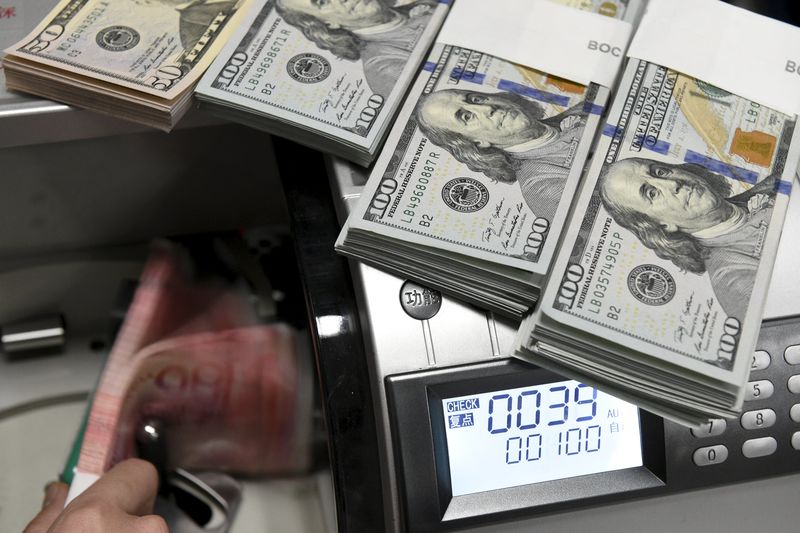One & One Green Technologies stock soars 100% after IPO debut
* Euro repels dollar bounce
* Yen firm, gold soaring as U.S. yields crater
* Yuan rides weak dollar to 5-month high
* Graphic: World FX rates in 2020 https://tmsnrt.rs/2RBWI5E
By Tom Westbrook
SINGAPORE, Aug 5 (Reuters) - The dollar fell in Asia on
Wednesday, hitting a five-month low on the yuan, as the latest
coronavirus relief package stalled in Congress and U.S. yields
sank on the prospect that further monetary easing might be
needed to support the economy.
A hardening perception that the U.S. recovery is lagging
Europe has buttressed the euro, which has repelled a rebound in
the dollar and rose back above $1.18 on Wednesday.
At the same time speculation that stalemate over fiscal
policy in Washington could leave the Federal Reserve with more
to do, has hastened a steady decline in U.S. yields -
undermining the dollar more broadly.
Sterling, the Australian dollar and the kiwi all climbed
back toward pre-pandemic highs, while the yen rose and gold
soared as real yields plumbed record lows.
"U.S. economic outperformance, relative to the eurozone and
Japan, is no longer guaranteed given the damage from the
COVID-19 pandemic," said Tai Hui, J.P. Morgan Asset Management's
chief strategist in Asia.
"Dollar interest rates are also converging to other
developed economies' interest rates, which means that the dollar
is less appealing," he said, adding it is difficult to see the
Fed easing policy ahead of its global peers.
The Australian dollar AUD=D3 led gains among the majors
with a 0.4% rise to $0.7189. Ten-year Australian government debt
AU10YT=RR now yields about 31 basis points more than 10-year
U.S. government debt, up from 16 basis points two months ago.
The New Zealand dollar NZD=D3 rose 0.3% to $0.6646,
catching some support from a surprise dip in the jobless rate.
The yen JPY= rose 0.1% to 105.60 per dollar and sterling
GBP= edged higher to $1.3091.
Even the Chinese yuan, which had struggled to capitalise on
the dollar's weakness amid simmering Sino-U.S. tensions, forged
higher to a five-month top of 6.9570 per dollar in onshore trade
CNY= . CNY/
Other Asian currencies also made gains, notably the
Malaysian ringgit MYR= which was stronger than 4.2 per dollar
for the first in five months.
DIVERGENCE
The dollar has been sliding since March, but its prime
antagonist in recent weeks has been the euro, which in July
posted its best month in almost 10 years.
That has the common currency more or less back where it
began life in 1999 and has many investors convinced it can keep
climbing as a Europe-wide fiscal relief package anchors recovery
and allays perennial worries about the bloc's stability.
"Right now, looming long-term negative U.S. issues – like
the dollar's reserve status as the U.S. and China decouple – are
at the forefront of FX concerns, and not the euro's structural
problems," said Deutsche Bank strategist Alan Ruskin.
"The door to $1.20+ remains wide open," he said.
For now, eyes are on Washington where White House
negotiators have vowed to work "around the clock" with
congressional Democrats to try to reach a deal on coronavirus
relief by the end of this week. The next economic updates are due later on Wednesday, with
services surveys in Britain and Europe in the morning and U.S.
private payrolls data around 1215 GMT.
Investors expect steady services growth in Europe and a
slowdown in U.S. in hiring, with surprises on any front likely
to illuminate the apparent divergence between Europe and the
United States.
Analysts at ING have also noted that equity investors have
yet to really buy in to the European recovery story - and say a
pile-in could provide even more support to the currency.
"Buy-side surveys suggest that investors are still heavily
overweight U.S. equities, especially tech stocks, and are minded
to rotate into the Eurozone and see the euro as cheap," said
ING's global head of markets Chris Turner.
"If that rotation comes to pass ... then euro/dollar may be
a $1.25 story after all."
